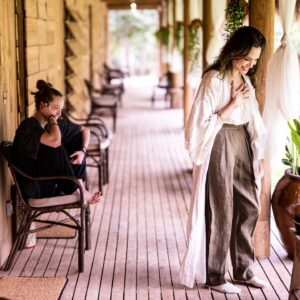
Ryan Phillippe: The Ageless Actor
Ryan Phillippe is not just a well-known actor; he is a symbol of defying age with his impressive physique and dedication to fitness.
At 50 years old, he recently shared an eye-catching post on Instagram showcasing his toned abs.
This post has caught the attention of fans and fitness enthusiasts alike.
With his forest green Alo shorts pulled low to reveal his Calvin Klein underwear, Phillippe is not afraid to flaunt his hard-earned body.
But there’s more to his story than just looks.
A Snap from The Mid Atlantic
In his Instagram post on December 18, Phillippe expressed his joy over a beautiful warm day on the Mid Atlantic east coast.
He shared his mood-boosting experience, highlighting the positive impact of good weather.
“Even the ladybug thinks it’s spring,” he captioned his post, showcasing a fun moment with nature.
Family Moments
Among his fitness-focused snaps, he also included a heartwarming photo of him cradling his grand-niece.
The juxtaposition of showcasing a strong physique while also embracing family shows a well-rounded individual who balances health and personal life.
The Thirst Trap Phenomenon
Phillippe is not shy about sharing shirtless pictures.
He recently posed in front of a stunning sunset while relaxing in a hot tub, mesmerizing fans with his captivating gaze.
His confidence shines through in these photos, reinforcing that being in shape is not just about physical appearance but also embracing one’s self-image at any age.
A Bonding Moment with His Son
In addition to his solo posts, he also shares moments with family.
Earlier in 2023, Ryan posed with his son, Deacon.
This black-and-white photo not only shows the bond between father and son, but also highlights how age does not define their connection.
Ryan’s embrace of Deacon shows love and strength, both physically and emotionally.
The Routine Behind His Abs
In a previous interview with Muscle and Fitness, Ryan discussed his “prison-style workout” routine.
This phrase may bring to mind intense physical training practices.
Ryan shared, “As you get older, you get half the results for twice the work.”
His perspective emphasizes that fitness is a lifelong journey.
What Does His Workout Entail?
Phillippe follows a rigorous workout regimen that includes:
- Leg Raises: Great for core strength.
- Bicycle Crunches: An effective way to target obliques.
- Box Jumps: These boost cardiovascular fitness and agility.
- Bench Presses: A staple for building upper body strength.
- Squats: Essential for leg and core strength.
- Chin-Ups: Fantastic for developing back and arm muscles.
His routine shows that consistency and effort yield significant results, emphasizing the importance of discipline in fitness.
Nutrition and Aging Well
Phillippe believes in the power of nutrition as a core element of staying fit.
He mentions that “if you don’t want [aging] to be as devastating as it can be, take care of yourself.”
This highlights the relationship between healthy eating and managing the effects of aging.
For more on nutrition and aging, check out these tips.
The Power of Dedication
Ryan’s dedication to maintaining his physique is commendable.
He stresses that he has never let himself get lazy when it comes to workouts.
This mindset serves as an inspiration for many who wish to stay fit and healthy as they age.
The Impact of Social Media on Perceptions of Aging
Understanding Aging in the Digital Age
Aging is a natural part of life, but how we perceive it can vary significantly based on cultural influences, societal expectations, and personal experiences.
Social media has become a powerful tool for shaping perceptions, including those about aging.
As we scroll through platforms like Instagram, Facebook, and TikTok, we are constantly exposed to images and messages about how people live and age.
The Perfect Illusion of Youth
Social media has created an environment where people often showcase their best selves.
This phenomenon frequently leads to curated images that glorify eternal youth and fitness, projecting an unrealistic standard of beauty and vitality.
Many influencers and celebrities, for instance, present a polished version of aging, often using filters and editing tools to enhance their appearance.
The Role of Influencers
Influencers play a pivotal role in shaping societal standards and norms related to beauty and aging.
When followers see their favorite celebrities or influencers sharing youthful, toned bodies, it can create unrealistic expectations about how aging should look.
Consequently, this can lead to pressure to maintain a youthful appearance, affecting people’s self-esteem, particularly among older adults.
Comparison Culture: The Downside of Social Media
One of the significant drawbacks of social media is the tendency for users to compare themselves to others.
This behavior can exacerbate feelings of inadequacy and anxiety, especially concerning aging.
When individuals frequently see images of seemingly perfect bodies and happy lives, it can lead to discouragement regarding their own aging process.
The Psychological Effects
The psychological effects of this comparison culture can be profound.
Many individuals may experience feelings of inadequacy, low self-worth, or depression as they feel they do not measure up to the unrealistic ideals presented online.
Social media can make aging seem like a negative or undesirable experience, reinforcing harmful stereotypes about aging and those who are older.
Body Positivity and Aging
Despite the negative aspects, social media has also been a platform for positive movements like body positivity and acceptance of aging.
Many influencers and advocates promote messages that celebrate aging and challenge societal norms regarding beauty.
Embracing Authenticity
Initiatives like #AgePositive encourage individuals to share their authentic selves, highlighting the beauty that comes with age.
This movement aims to redefine what it means to age gracefully and promote self-acceptance among all ages.
The celebration of natural beauty, including wrinkles, gray hair, and body changes, can provide a refreshing counter-narrative to the dominant youth-centric culture prevalent on social media.
How Social Media Shapes Conversations About Aging
Social media platforms are not just arenas for showcasing beauty; they also foster important conversations about aging and its challenges.
Connecting Generations
Through social media, people of different generations can connect and engage in discussions about aging.
This connection can provide valuable perspectives and insights, helping to bridge the gap between younger and older individuals.
Sharing Experiences
Users can share their experiences with aging, such as dealing with health changes, adjusting to new life stages, or embracing self-care routines.
These shared stories can help demystify aging and remind individuals that they are not alone in their experiences.
The Influence of Media Representation
Media representation plays a significant role in shaping perceptions of aging.
Movies, television shows, and advertisements often portray older individuals in negative or secondary roles.
Challenging Stereotypes
However, social media offers the opportunity to challenge these stereotypes.
Users can take control of their narratives and present themselves authentically, showcasing the vibrancy and diversity of aging experiences.
By sharing their stories and images, individuals can help normalize aging and work towards changing societal perceptions.
The Essential Role of Family in Maintaining Mental Health as We Age
Understanding Aging and Mental Health
As we age, maintaining our mental health becomes increasingly important.
Mental well-being affects how we think, feel, and behave in daily life.
Aging can bring various challenges, including physical health issues, the loss of loved ones, and changes in living situations.
In such times, family can play a crucial role in supporting mental health and ensuring that older adults lead fulfilling lives.
Emotional Support: The Foundation of Mental Well-Being
One of the most significant roles of family is providing emotional support.
Having family members to talk to, share feelings with, and lean on during tough times can greatly reduce the loneliness that often accompanies aging.
The Importance of Sharing Feelings
When older adults have family members who encourage open communication, they feel more connected and included.
This connection can alleviate feelings of isolation and depression.
Families that regularly check in on their older relatives foster a supportive environment that promotes mental health.
Recognizing Signs of Distress
Family members can also play an important role in recognizing signs of mental distress.
They may notice changes in behavior or mood that the individual may not acknowledge.
By being aware and attentive, families can intervene early and seek necessary support or professional help when needed.
For more information on mental health awareness, visit MentalHealth.gov.
Social Engagement: Staying Connected
Family connections contribute significantly to social engagement, which is vital for mental health.
Social interaction helps combat isolation and loneliness, which can lead to severe mental health issues in older adults.
Family Gatherings and Activities
Regular family gatherings, whether they are simple dinners or celebrations, provide opportunities for older adults to socialize and connect.
These occasions enhance emotional bonds and create lasting memories.
Using Technology to Stay Connected
In today’s digital age, technology can also bridge distances.
Video calls and social media allow families to maintain connections, even if they live far apart.
For older adults, learning to use such technology can be empowering and boost their self-esteem.
Explore resources on technology for seniors to help them stay connected.
Shared Experiences: Building Stronger Bonds
Participating in shared experiences can strengthen family relationships and improve mental health.
Whether it’s a family trip, a hobby, or volunteering together, these activities create a sense of belonging.
Engaging in Hobbies
Encouraging older adults to engage in hobbies with family members can spark joy and excitement.
Shared interests, such as gardening, cooking, or crafting, provide avenues for creativity and collaboration.
These activities not only enhance mental well-being but also strengthen family ties.
Celebrating Achievements Together
Recognizing and celebrating achievements, no matter how small, promotes positivity.
Family members can take time to acknowledge the accomplishments of their older relatives, fostering a sense of worthiness and value.
This recognition can motivate older adults to pursue new goals and continue engaging in life.
The Caregiver Role: Challenges and Support
While family support can enhance mental health, being a caregiver for aging relatives can also present challenges.
Caregivers often experience stress, anxiety, and burnout due to the demands of providing care.
Balancing Care and Personal Life
Family caregivers must learn to balance their roles with their personal lives.
Taking time for self-care is essential, as it ensures that caregivers can provide adequate support without becoming overwhelmed.
By maintaining their own mental health, caregivers can better assist their aging relatives.
For tips on caregiver self-care, visit CaregiverAction.org.
Seeking Help and Resources
Families can also seek external support through community resources or professional help.
This approach not only benefits the caregiver but also ensures that older adults receive comprehensive care and attention.
Such resources can alleviate the pressure and provide valuable information for families navigating aging challenges.
Check out AgingCare.com for useful resources on elder care.
Overcoming Family Challenges and Conflicts
While many family dynamics foster positive mental health, conflicts can arise.
Disagreements about caregiving, finances, or living arrangements may create stress.
Effective Communication as a Solution
Open and honest communication is crucial for resolving conflicts.
Family meetings can provide a platform for discussing concerns, addressing grievances, and finding solutions collaboratively.
When families approach conflicts respectfully, they can strengthen their bonds and reduce stress.
Embracing Change Together
Aging can bring significant changes that affect the entire family.
Acknowledging these changes together and finding ways to adapt promotes resilience.
Families that support one another through transitions are better equipped to handle the challenges of aging.
Adapting Fitness Routines for Healthy Aging: A Guide for Seniors
Understanding the Need to Adapt Fitness Routines
As we age, our bodies undergo various changes.
These changes can affect our energy levels, strength, flexibility, and overall health.
Maintaining a consistent fitness routine is crucial, as it helps promote longevity, reduces the risk of chronic diseases, and enhances our quality of life.
However, to continue reaping the benefits of exercise, it’s important to adapt fitness routines to meet our evolving needs.
The Benefits of Exercise for Older Adults
Exercise offers numerous benefits for older adults that go beyond physical fitness.
Regular physical activity can:
- Improve cardiovascular health and circulation.
- Enhance muscle strength and endurance.
- Increase bone density and reduce the risk of osteoporosis.
- Improve balance and coordination, reducing the risk of falls.
For more insights into the benefits of exercise, visit CDC’s Physical Activity Guidelines.
Mental Health Benefits
In addition to physical health, exercise significantly impacts mental well-being.
Staying active can reduce symptoms of depression and anxiety, boost mood, and improve cognitive function.
Engaging in physical activity, especially in social settings, also fosters a sense of community and connection.
For more on how exercise benefits mental health, visit MentalHealth.gov.
Modifying Strength Training for Aging Bodies
Strength training is essential for maintaining muscle mass and bone health as we age.
However, the way we approach weightlifting should be modified to ensure safety and effectiveness.
Focus on Form Over Weight
One key adjustment is prioritizing proper form over the amount of weight lifted.
Good form reduces the risk of injury and maximizes the benefits of each exercise.
Using lighter weights with more repetitions can be an effective strategy to build strength without excessive strain.
For tips on maintaining proper form, explore ACE Fitness.
Incorporate Resistance Bands
Incorporating resistance bands into workouts is a great way to add strength training without heavy weights.
Resistance bands are gentle on the joints, making them an excellent option for older adults.
They offer a range of resistance levels and are versatile enough for various exercises targeting different muscle groups.
To learn more about resistance band exercises, visit Healthline’s guide.
Cardiovascular Fitness: Heart Health at Any Age
Cardiovascular fitness remains critical, and adapting routines is essential for older adults.
Walking, swimming, and cycling are excellent low-impact options that can be easily adjusted for individual fitness levels.
Start Slow and Build Gradually
For those who are new to exercise or returning after a break, it’s important to start slowly.
Gradually increasing intensity allows the body to adjust and reduces the risk of injury.
Aim for at least 150 minutes of moderate aerobic exercise per week, broken down into manageable sessions.
For detailed guidelines on physical activity, refer to the CDC’s Physical Activity Guidelines.
Interval Training for Efficiency
As fitness levels improve, incorporating interval training can be beneficial.
This involves alternating between periods of higher-intensity activity and lower-intensity recovery.
Such training enhances cardiovascular fitness efficiently while being adaptable to any fitness level.
Check out Mayo Clinic’s insights on interval training for additional tips.
Flexibility and Balance: The Key to Stability
Maintaining flexibility and balance is crucial as we age to prevent falls and injuries.
Incorporating stretches and balance exercises into fitness routines ensures comprehensive physical health.
Incorporate Stretching Routines
Regular stretching improves flexibility and can alleviate stiffness associated with aging.
Simple stretches can be included in daily routines, focusing on major muscle groups.
Yoga and Pilates are excellent disciplines that promote flexibility, balance, and relaxation.
For more information on these practices, visit Yoga Journal.
Balance Training Exercises
Balance exercises, such as tai chi or specific stability workouts, help older adults enhance their coordination.
These exercises reduce the risk of falls, which can lead to serious injuries.
Even simple activities like standing on one leg or using a balance board can be effective.
To learn more about balance exercises, check out Verywell Fit’s guide.
Mind-Body Connection: Integrating Mental Wellness
Physical fitness is closely linked to mental wellness.
Integrating mind-body practices into exercise routines can foster a holistic approach to health.
Mindful Movement
Incorporating mindfulness into workouts, such as through yoga or meditation, enhances the mind-body connection.
Practices that encourage being present can reduce stress and improve overall well-being.
Mindfulness in exercise helps older adults listen to their bodies and adjust routines according to how they feel.
For techniques on mindfulness, visit Mindful.org.
Social Interaction Benefits
Engaging in group classes or activities adds a social element to fitness.
Regular interaction with peers boosts motivation and encourages consistency.
Many older adults find that participating in group activities helps alleviate feelings of loneliness and boosts morale.
Explore potential activities through Meetup.com.
Encouraging Individualization of Routines
Every individual’s fitness journey is unique, and routines should reflect personal preferences and abilities.
Family members and caregivers can play an important role in supporting older adults in finding activities they enjoy.
Customizing Workouts
Customizing workouts to fit personal interests and limitations increases adherence to the routine.
Some may prefer low-impact classes, while others may enjoy outdoor activities.
Exploring various options can lead to discovering enjoyable fitness practices that promote long-term commitment.
For ideas on customized fitness routines, visit AARP’s fitness resources.
Consulting Professionals for Guidance
Older adults should consider seeking professional guidance when adapting fitness routines.
Certified trainers familiar with senior fitness can provide invaluable insights and modifications.
Healthcare providers can also recommend safe exercises based on individual health conditions or mobility limitations.
For a directory of certified trainers, check out National Academy of Sports Medicine (NASM).



















